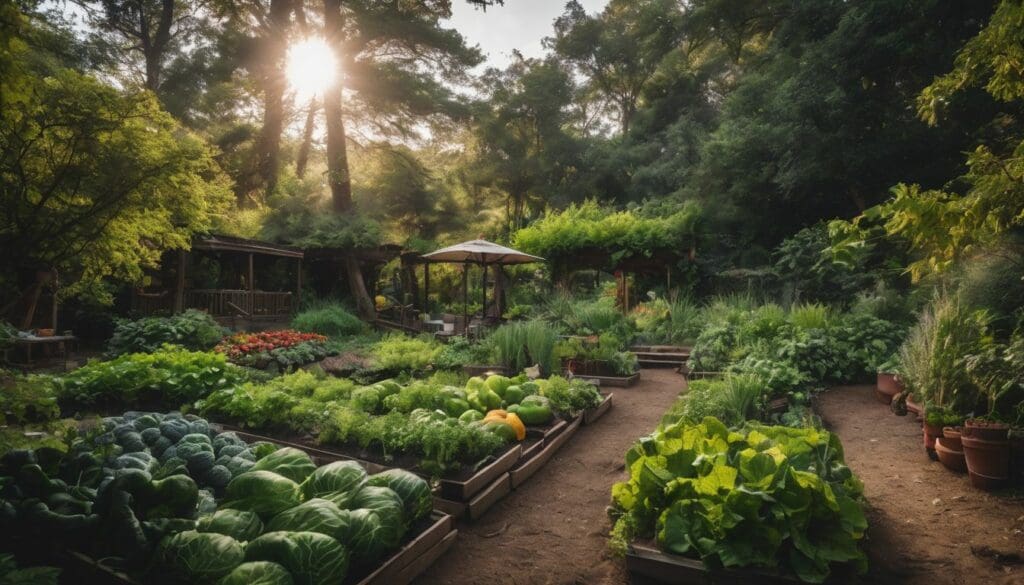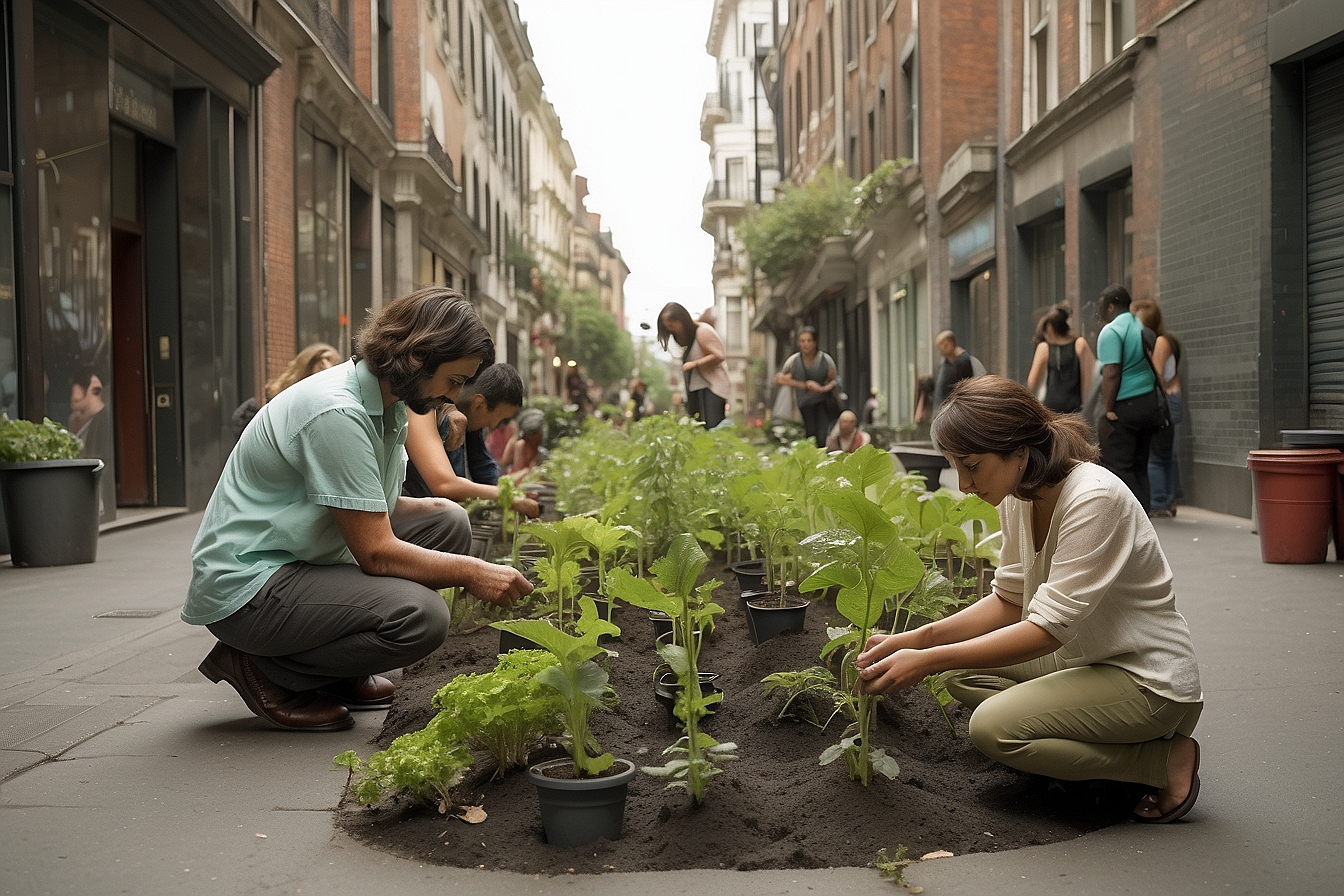Many of us harbour the delightful dream of cultivating a garden that’s not only a feast for the eyes but also one that provides a bounty for the table. That vision has captured our imagination as well, and with the enticing fact that an average food forest can absorb four times more carbon than a traditional monoculture lawn, we’ve been inspired to delve into the world of edible forest gardening.
In this feature, we’ll take you by the hand and lead you through each meticulous step needed to create your very own verdant, fruitful haven. So let’s roll up our sleeves together and embark on this journey to turn your patch of green into something truly extraordinary!
Key Takeaways
- A food forest mimics a natural ecosystem and focuses on growing edible plants in multiple layers, offering environmental benefits like better soil fertility, more biodiversity, and greater carbon sequestration compared to traditional monoculture lawns.
- By embracing this permaculture approach of companion planting and diversity, yields can be increased with reduced maintenance costs while promoting a balanced ecosystem that supports wildlife.
- When setting up your own food forest garden, consider factors such as location suitability for sunlight exposure, water availability, soil quality and layout based on plant growth habits to ensure long-term success and sustainability.
Understanding the Concept of a Food Forest
A food forest is a diverse, multi-layered planting of edible plants that mimics the structure and function of a natural forest ecosystem. Unlike traditional monoculture gardens, food forests are designed to be self-sustaining and require minimal maintenance once established.
They offer numerous benefits for the environment, such as improving soil fertility, increasing biodiversity, and sequestering carbon from the atmosphere.
Definition of a food forest
A food forest mimics a natural ecosystem, primarily focusing on edible plants and trees. We layer these plants in such a way that they work together like a community, creating a diverse and self-sustaining system.
In our design, we include everything from tall canopy trees to shrubby undergrowth, ground cover crops to root vegetables, and climbers that weave through the spaces in between.
We plant perennials alongside annuals, ensuring year-round productivity and less disruption of the soil compared with conventional agriculture. This harmonious blend of plants supports biodiversity whilst optimising space – yielding an abundance of fruits, nuts, herbs, and vegetables.
Think of it as an intricately woven tapestry where each thread is essential; supporting sustainable agriculture through agroforestry practices that nurture both people and planet.
Comparison to traditional monoculture gardens
Traditional monoculture gardens focus on the cultivation of a single crop over a wide area, contrasting with the diverse plantings in a food forest. We observe a significant difference in the approach to planting, harvesting, and maintaining these two garden types.
| Criteria | Traditional Monoculture Gardens | Food Forests |
|---|---|---|
| Diversity | Low – single crop variety. | High – multiple species coexist. |
| Maintenance | High – requires regular tilling and weeding. | Low – designed to be self-sustaining. |
| Soil Health | Can degrade over time due to lack of diversity. | Improves with varied root systems and organic matter. |
| Pesticide Use | Often high – single crops are more susceptible to pests. | Reduced – natural pest control through biodiversity. |
| Ecosystem | Limited wildlife due to uniform crop. | Supports a range of wildlife, creating a balanced ecosystem. |
| Water Usage | Often inefficient, leading to runoff and waste. | More efficient due to mulch and canopy layers. |
| Yield | May be higher in the short term for the singular crop. | Higher overall yield due to multiple species. |
| Climate Resilience | Lower due to reliance on one crop type. | Higher due to diversity and natural systems. |
We see that our food forests provide a resilient and sustainable alternative to traditional monoculture approaches. They embody the principles we champion in promoting environmental conservation.
Benefits for the environment and climate change
In contrast to traditional monoculture gardens, growing an edible forest garden offers numerous benefits for the environment and climate change. The design of food forests mimics natural ecosystems, promoting biodiversity and providing habitat for pollinators and beneficial insects.
Deep-rooted perennial plants help prevent erosion, stabilise soil structure, and improve the overall health of the ecosystem. By sequestering carbon dioxide from the atmosphere through the growth of trees and perennial crops, food forests contribute to mitigating climate change.
Additionally, the diverse mix of plant species in a food forest supports soil health by enhancing nutrient cycling and reducing the need for chemical inputs.
Steps to Create Your Own Food Forest
When creating your own food forest, it’s important to start by setting goals and observing the site. Designing the layout and choosing the right plants, then preparing the soil and sourcing your plants are crucial steps for success.
Goal-setting and observation
When establishing a food forest, we begin by setting clear goals for the project. By defining our objectives, such as creating a self-sustaining ecosystem or cultivating specific edible plants, we can tailor our design and plant selection accordingly.
Additionally, careful observation of the site’s characteristics is crucial. We assess factors like sunlight exposure, soil composition, and water availability to inform our layout and plant choices effectively.
To achieve success in creating an edible forest garden, we set clear goals aligned with our vision and observe the natural conditions of the site before embarking on the planting process.
Designing the layout and choosing plants
To design the layout of our edible forest garden, we carefully consider the space available, sunlight exposure, and water sources. We plan for various plant heights to optimise light capture and create a balanced ecosystem.
Selecting plants is based on their ability to coexist harmoniously within the food forest environment, considering their size, root depth, spread, and compatibility with neighbouring species.
Intercropping techniques allow us to maximise space usage while promoting biodiversity.
The choice of plants in our food forest involves selecting a mix of fruit trees, perennial herbs, low-growing plants like berries or ground covers, nitrogen-fixing legumes for soil health improvement, and pollinator-attracting flowers.
By choosing varieties that are well-adapted to local conditions and enhancing plant diversity within the system through companion planting principles; we increase resilience against pests and diseases while supporting beneficial interactions between different species.
Preparing the site and sourcing plants
To create a thriving food forest, we start by selecting an appropriate site in terms of location and sunlight exposure. Next, we carefully prepare the soil to ensure it is conducive for plant growth.
It’s important to source a diverse range of plants that are suitable for the local climate and soil conditions. This includes both fruit-bearing trees, bushes, ground cover plants, and perennial vegetables.
By choosing a variety of plants with different needs and benefits, we establish a balanced ecosystem within our food forest.
Once the site is ready, we begin planting our selection of trees, shrubs, herbs, and other edibles in stages. Ensuring proper spacing between plants allows each one to flourish without competing for resources.
Planting in stages and proper spacing
To ensure the success of our food forest, we implement a strategic approach to planting in stages and carefully consider proper spacing between plants. This allows us to gradually establish different layers within the ecosystem while giving each plant enough space and resources to thrive without competing excessively with others.
By starting with the canopy trees, followed by understory trees, shrubs, herbaceous plants, ground covers, and vines in subsequent stages, we create a diverse and harmonious environment that mimics natural forest systems.
Proper spacing is key to prevent overcrowding as well as allowing for optimal light exposure, air circulation, and nutrient uptake for each plant.
We also take into account the growth habits of each species when determining their placement within the food forest. Understanding mature sizes ensures that taller species do not overshadow smaller ones or block sunlight from reaching important layers below.
Factors to Consider in Food Forest Creation
When creating a food forest, it’s important to consider factors like the location, sunlight, soil quality, and water availability. Planning the layout based on plant growth habits and practicing companion planting are also essential for a successful edible forest garden.
Location, sunlight, soil, and water availability
When selecting the location for your food forest, look for an area with full sunlight exposure and well-draining soil. Consider existing water sources or options for irrigation to ensure proper moisture levels. Evaluate the available space and note any nearby structures that could provide shade.
Layout planning based on plant growth habits
When planning the layout of your food forest, consider the growth habits of different plants. This will help in maximising space and ensuring a harmonious coexistence among them. Here are key factors to consider when planning the layout:
- Group tall trees at the north end of your site to avoid shading shorter plants.
- Place shrubs and bushes in mid-layers to provide support for climbing plants while creating shade for lower-growing species.
- Intersperse ground cover plants between taller specimens to maximise space and reduce weed growth.
- Arrange plants with similar water needs together to simplify irrigation maintenance.
- Design pathways that allow easy access for harvesting while minimising compacting soils around plant roots.
- Incorporate diversity in plant placement to enhance pest control and pollination through natural ecosystems.
Companion planting principles
When choosing plants for your food forest, consider companion planting principles. Pairing compatible plant species can enhance growth and deter pests naturally. For instance, interplanting aromatic herbs like basil and mint with vegetables can protect them from insect infestations while also providing a diverse range of produce.
Additionally, legumes such as beans or peas contribute nitrogen to the soil, benefiting neighboring plants like corn or squash. Embracing these principles encourages a healthy ecosystem within your edible forest garden and promotes sustainable, organic gardening practices that benefit both the environment and crop yield.
By adhering to companion planting principles in our food forests, we cultivate harmonious relationships between different plant species, bolster biodiversity, reduce the need for harmful chemicals and create a resilient agricultural system that mirrors natural ecosystems.
Soil preparation techniques
To prepare the soil for our food forest, we start by clearing the site from any debris and weeds. Then, we dig organic matter like compost or well-rotted manure into the soil to improve its structure and fertility.
It’s important to test the pH of the soil and make necessary adjustments using materials such as lime or sulphur. Finally, we mulch the area with organic materials to retain moisture, suppress weeds, and encourage beneficial microbial activity in the soil.
Next, we utilise techniques such as sheet mulching or lasagna gardening to gradually build up layers of organic matter over time. This helps create a fertile growing environment while reducing weed growth without disturbing underlying soil layers.
Plant selection and diversity
When selecting plants for your food forest, consider a diverse range of species that complement and support each other. By including a variety of trees, shrubs, vines, and ground covers, you can create a balanced ecosystem that maximises productivity and supports biodiversity.
Choosing plants with different growth habits, root depths, and nutrient requirements will help minimise competition and create a more resilient and self-sustaining garden. Additionally, incorporating native species into your food forest will enhance the overall ecological value of your garden by providing habitat for local wildlife and supporting the surrounding ecosystem.
To ensure long-term success in your food forest venture while promoting sustainability read on to understand essential factors to consider concerning plant selection and diversity.
Benefits of Growing a Food Forest
– Food forests provide increased yields and productivity due to the diverse mix of plants and trees, resulting in a more sustainable food source. In addition, they require reduced maintenance and costs compared to traditional gardens, while also promoting improved biodiversity and ecosystem health.
Increased yields and productivity
Growing a food forest can significantly increase yields and productivity compared to traditional gardens. By utilising vertical space, intercropping, and layering of plants with different growth habits, a food forest maximises every inch of available land.
This results in higher overall crop yield per square foot than monoculture gardening methods. Additionally, the diverse mix of trees, shrubs, and groundcover plants creates natural microclimates that are beneficial for plant growth and fruit production.
Moreover, as a result of this diversity, food forests are less susceptible to pest outbreaks or disease due to the varied species present within the ecosystem. This reduces the need for chemical interventions or intensive management practices whilst promoting healthier soil and plant development.
Ultimately, growing an edible forest garden not only increases your self-sufficiency but also contributes positively to local biodiversity and environmental conservation efforts.
Reduced maintenance and costs
After increasing yields and productivity, reducing maintenance and costs becomes an essential aspect of managing a food forest. With proper planning and implementation, a food forest requires minimal ongoing maintenance.
This approach not only saves time but also significantly cuts down on the costs associated with traditional gardening methods. By choosing native plants that thrive in the local climate and ecosystem, you can minimise the need for artificial inputs such as fertilisers or pesticides, resulting in both environmental and financial benefits.
In addition to reduced maintenance needs, the diverse plantings within a food forest create a self-sustaining ecosystem that promotes natural pest control and soil fertility. As plants grow together symbiotically, they contribute to each other’s growth patterns and overall health without requiring excessive human intervention.
Improved biodiversity and ecosystem health
Transitioning from reduced maintenance and costs to the advantages of a food forest, growing an edible forest garden also contributes to improved biodiversity and ecosystem health.
By cultivating a diverse range of plants within the same space, we can create habitats for various species, including beneficial insects and pollinators. This promotes natural pest control and enhances soil fertility through the interaction of different plant roots, further supporting ecosystem health.
Additionally, the presence of diverse flora fosters a balanced microclimate within the garden, regulating temperature and humidity while reducing water runoff and erosion. Ultimately, embracing polyculture gardening practices not only enriches our immediate surroundings but also plays a vital role in broader environmental conservation efforts.
Additional Resources and Recommended Readings
For those interested in delving deeper into the world of food forests, we recommend checking out our free food forest starter pack and signing up for a foraging and herbalism email course.
You can also explore other articles and books on forest gardening to enhance your knowledge and skills.
Free food forest starter pack
We offer a free food forest starter pack to kickstart your edible garden journey. This resource includes valuable information on selecting the right plants, designing your layout for maximum efficiency, and tips for maintaining a healthy and thriving food forest.
Our aim is to empower you with the knowledge and tools needed to create a self-sufficient and ecological garden that contributes positively to the environment.
By using our free starter pack, you can take proactive steps towards regenerative farming while enjoying the benefits of urban farming in your own backyard or community space. So let’s dive into this exciting adventure of creating an abundant food forest that supports biodiversity and sustainability in today’s world!
Foraging and herbalism email course
Enrol in our fascinating foraging and herbalism email course to unearth the natural world’s bounty on your doorstep. Learn valuable skills to identify, harvest, and use wild edible plants while nurturing a deeper connection with nature.
Discover the medicinal properties of common herbs and their practical applications, supporting your journey towards self-sufficiency in an ecological gardening setting.
Explore sustainable living through foraging and herbalism as we delve into centuries-old practices that not only enhance personal well-being but also contribute positively to environmental conservation efforts.
Other articles and books on forest gardening
Explore further knowledge about forest gardening with our recommended articles and books. Discover comprehensive guides on advanced gardening techniques, self-sufficient gardening, and agroecology.
Learn how to create a flourishing food forest while supporting conservation efforts and environmental sustainability. Immerse yourself in the rich world of edible landscaping, organic permaculture practices, and innovative agroforestry strategies that promote biodiversity and ecosystem health.
With these resources at your fingertips, you can take proactive steps towards establishing an environmentally sound garden that yields abundant produce in harmony with nature.
Delve into free food forest starter packs for practical insights on designing your own thriving ecosystem. Uncover valuable wisdom through specialised courses on foraging and herbalism to deepen your understanding of sustainable living.
Conclusion
Embrace the beauty and bounty of nature with your very own food forest. Create an ecosystem that sustains itself, contributing to environmental conservation. Reap the rewards of a self-sufficient garden while supporting biodiversity and enjoying fresh produce right at your doorstep.
Let’s embark on this enriching journey towards sustainable living today!
FAQs
1. What is an edible forest garden?
An edible forest garden is a way of planting that mimics a natural forest but consists mainly of trees, shrubs, and plants that produce food you can eat.
2. Can I grow an edible forest garden in my backyard?
Yes, with the right planning and care, you can cultivate an edible forest garden in your backyard to enjoy self-sufficient gardening.
3. How much work does it take to maintain an edible forest garden?
Once established, an edible forest garden requires less maintenance than traditional gardens because it works with natural processes for growth and health.
4. What are the benefits of having an edible forest garden?
Edible forests provide fresh produce right from your garden while also creating a habitat for wildlife and contributing to environmental sustainability.





